The global multiparameter patient monitoring systems market is likely to reach from USD 13.7 billion in 2025 to approximately USD 24.1 billion by 2035, recording an absolute increase of USD 10.4 billion over the forecast period. This translates into a total growth of 76.0%, with the market forecast to expand at a compound annual growth rate (CAGR) of 5.8% between 2025 and 2035. The market size is expected to grow by nearly 1.8X during the same period, supported by increasing prevalence of chronic diseases, rising geriatric population, technological advancements in monitoring devices, and growing demand for remote patient monitoring solutions.
Quick Stats for Multiparameter Patient Monitoring Systems Market
Between 2025 and 2030, the multiparameter patient monitoring systems market is projected to expand from USD 13.7 billion to USD 18.1 billion, resulting in a value increase of USD 4.4 billion, which represents 42.3% of the total forecast growth for the decade. This phase of growth will be shaped by increasing healthcare digitization, rising demand for continuous patient monitoring, growing adoption of wireless and portable monitoring systems, and expanding healthcare infrastructure in emerging markets. Healthcare providers are investing in advanced monitoring technologies to enhance patient safety and improve clinical outcomes.
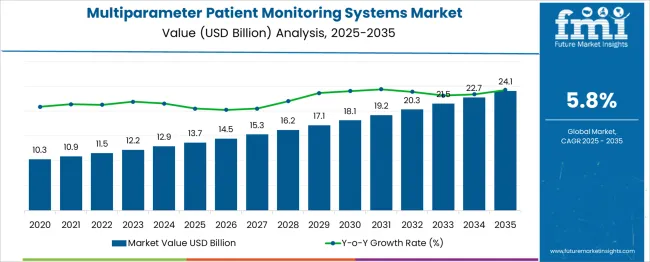
| Metric | Value |
| Estimated Value in (2025E) | USD 13.7 billion |
| Forecast Value in (2035F) | USD 24.1 billion |
| Forecast CAGR (2025 to 2035) | 5.8% |
From 2030 to 2035, the market is forecast to grow from USD 18.1 billion to USD 24.1 billion, adding another USD 6.0 billion, which constitutes 57.7% of the ten-year expansion. This period is expected to be characterized by widespread adoption of AI-powered monitoring systems, integration of IoT technologies, development of cloud-based monitoring platforms, and expansion of telemedicine services. The growing priority on preventive healthcare and early detection of health complications will drive demand for sophisticated multiparameter monitoring systems with enhanced connectivity and analytical capabilities.
Between 2020 and 2025, the multiparameter patient monitoring systems market experienced significant expansion, driven by the COVID-19 pandemic's impact on healthcare infrastructure and the urgent need for continuous patient monitoring. The market developed as healthcare facilities recognized the critical importance of real-time patient data monitoring for managing critically ill patients and preventing adverse events. The pandemic accelerated the adoption of remote monitoring technologies and highlighted the need for scalable, flexible monitoring solutions across various healthcare settings.
Market expansion is being supported by the increasing prevalence of chronic diseases such as cardiovascular disorders, diabetes, and respiratory conditions that require continuous monitoring for effective management. The aging global population is creating substantial demand for monitoring systems as elderly patients typically require more intensive healthcare supervision and are prone to multiple comorbidities. Healthcare providers are increasingly focused on patient safety initiatives and regulatory compliance, driving adoption of advanced monitoring technologies that can detect early signs of patient deterioration.
The growing priority on value-based healthcare is encouraging hospitals and healthcare facilities to invest in monitoring systems that can improve patient outcomes while reducing healthcare costs through early intervention and prevention of complications. Technological advancements in sensor technology, wireless connectivity, and data analytics are enabling the development of more sophisticated and user-friendly monitoring systems. The rising demand for home healthcare and remote patient monitoring, particularly accelerated by the COVID-19 pandemic, is creating new opportunities for portable and wireless monitoring solutions.
The market is segmented by device, acuity level, age group, end-use, and region. By device, the market is divided into portable systems and fixed systems. Based on acuity level, the market is categorized into high acuity, medium acuity, and low acuity monitoring. In terms of age group, the market is segmented into geriatric, pediatric, and adult populations. By end-use, the market is classified into hospitals, home care settings, ambulatory surgical centers, and others. Regionally, the market is divided into North America, Europe, Asia Pacific, Latin America, and Middle East & Africa.

The high acuity monitoring segment is projected to account for 45.8% of the multiparameter patient monitoring systems market in 2025, reflecting the critical importance of comprehensive monitoring in intensive care units and critical care environments. High acuity patients require continuous monitoring of multiple vital parameters including ECG, blood pressure, oxygen saturation, temperature, and respiratory rate to detect any changes that could indicate life-threatening conditions.
This segment represents the most technologically advanced and feature-rich monitoring systems, designed to provide healthcare professionals with real-time data, advanced alarms, and sophisticated analytics capabilities. The growing number of critically ill patients, increasing complexity of medical procedures, and rising awareness about patient safety are driving demand for high acuity monitoring systems. Healthcare facilities are investing in advanced monitoring technologies to improve patient outcomes, reduce mortality rates, and ensure compliance with healthcare regulations and quality standards.
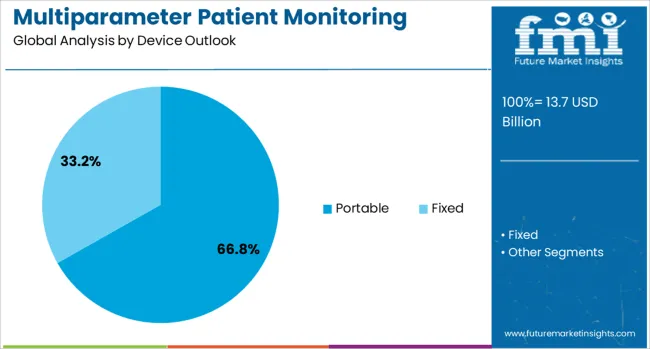
Portable systems are projected to represent 66.8% of multiparameter patient monitoring systems demand in 2025, underscoring the healthcare industry's shift toward mobility and flexibility in patient care. Portable monitoring systems offer healthcare providers the ability to monitor patients during transport, in multiple care settings, and in situations where fixed systems are not practical or cost-effective.
The segment benefits from technological advancements in battery technology, wireless connectivity, and miniaturization of sensors that have made portable systems more reliable and feature-rich. The growing demand for home healthcare services, remote patient monitoring, and point-of-care testing is driving adoption of portable monitoring solutions. Additionally, the COVID-19 pandemic highlighted the importance of flexible monitoring systems that can be rapidly deployed and relocated as needed, further accelerating demand for portable solutions.
The geriatric population is forecasted to contribute 54.2% of the multiparameter patient monitoring systems market in 2025, reflecting the unique healthcare needs of the rapidly aging global population. Elderly patients typically present with multiple chronic conditions, increased susceptibility to complications, and a greater need for continuous monitoring to prevent adverse events and ensure optimal treatment outcomes.
This segment drives demand for monitoring systems with specialized features such as fall detection, medication compliance monitoring, and integration with electronic health records for comprehensive care coordination. The growing priority on aging-in-place and home healthcare services is creating opportunities for portable and wireless monitoring solutions specifically designed for geriatric patients. Healthcare providers are investing in monitoring technologies that can help manage the complex healthcare needs of elderly patients while improving quality of life and reducing healthcare costs.
The multiparameter patient monitoring systems market is advancing rapidly due to increasing chronic disease prevalence, technological innovations in healthcare monitoring, and growing demand for remote patient care solutions. The market faces challenges, including high equipment costs, data security concerns, and regulatory compliance requirements. Innovation in artificial intelligence, IoT integration, and cloud-based monitoring platforms continues to influence product development and market expansion patterns.
Healthcare providers are increasingly adopting AI-powered monitoring systems that can analyze patient data patterns, predict potential health complications, and provide clinical decision support to healthcare professionals. Machine learning algorithms are being integrated into monitoring systems to reduce false alarms, improve diagnostic accuracy, and enable predictive analytics for better patient outcomes. These technologies help healthcare providers identify early warning signs of patient deterioration and intervene before critical situations develop.
The growing adoption of telemedicine and remote healthcare services is driving demand for monitoring systems that can transmit patient data to healthcare providers in real-time. Remote monitoring capabilities enable continuous patient supervision outside traditional healthcare settings, improving access to care and reducing healthcare costs. The COVID-19 pandemic significantly accelerated the adoption of remote monitoring technologies as healthcare systems sought to minimize in-person contact while maintaining quality patient care.
Modern monitoring systems are incorporating wireless technologies and Internet of Things (IoT) capabilities to enhance connectivity, mobility, and data sharing across healthcare networks. Wireless monitoring systems eliminate the constraints of traditional wired connections, enabling greater patient mobility and more flexible care delivery. IoT integration allows monitoring devices to communicate with other healthcare systems, electronic health records, and mobile devices for comprehensive patient data management.
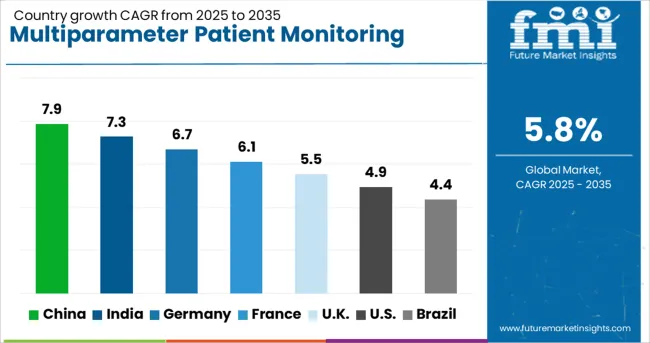
| Country | CAGR (2025-2035) |
| China | 7.9% |
| India | 7.3% |
| Germany | 6.7% |
| France | 6.1% |
| UK | 5.5% |
| USA | 4.9% |
The multiparameter patient monitoring systems market is experiencing strong growth globally, with China leading at a 7.9% CAGR through 2035, driven by massive healthcare infrastructure investments, aging population, and government healthcare reforms. India follows closely at 7.3%, supported by expanding healthcare access, rising chronic disease prevalence, and growing medical device manufacturing capabilities. Germany shows solid growth at 6.7%, prioritizing quality healthcare delivery and advanced medical technology adoption. France records 6.1%, focusing on healthcare system modernization and patient safety initiatives. The UK demonstrates 5.5% growth, prioritizing NHS efficiency improvements and digital health integration.
Revenue from multiparameter patient monitoring systems in China is projected to exhibit strong growth with a CAGR of 7.9% through 2035, driven by the government's substantial investments in healthcare infrastructure modernization and the rapidly aging population requiring intensive monitoring services. The country's healthcare reform initiatives are creating significant demand for advanced monitoring technologies across hospitals, clinics, and home healthcare settings.
Revenue from multiparameter patient monitoring systems in India is expanding at a CAGR of 7.3%, supported by rapid healthcare infrastructure development, increasing healthcare spending, and growing medical tourism industry. The country's large population base and rising incidence of lifestyle-related diseases are creating substantial demand for continuous patient monitoring solutions.
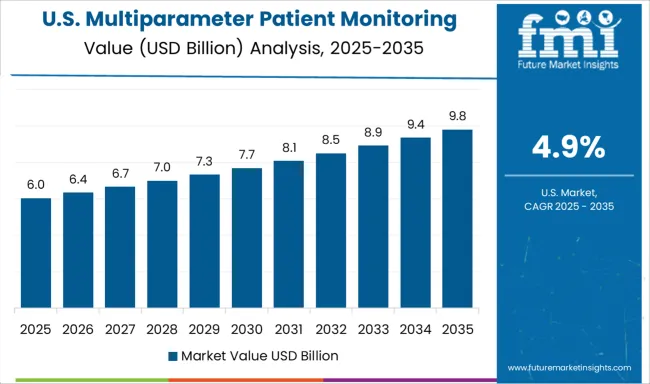
Demand for multiparameter patient monitoring systems in the USA is projected to grow at a CAGR of 4.9%, supported by stringent healthcare regulations, focus on patient safety, and advanced healthcare infrastructure. American healthcare providers are increasingly focused on reducing medical errors, improving patient outcomes, and achieving regulatory compliance through sophisticated monitoring technologies.
Revenue from multiparameter patient monitoring systems in Germany is projected to grow at a CAGR of 6.7% through 2035, driven by the country's strong prioritizing on healthcare quality, advanced medical technology adoption, and aging population demographics. German healthcare providers consistently invest in high-quality monitoring systems to maintain their reputation for excellent patient care and medical outcomes.
Revenue from multiparameter patient monitoring systems in France is projected to grow at a CAGR of 6.1% through 2035, supported by government healthcare modernization initiatives, aging population, and prioritizing on preventive healthcare. French healthcare providers are investing in advanced monitoring technologies to improve patient care quality and system efficiency.
Revenue from multiparameter patient monitoring systems in the UK is projected to grow at a CAGR of 5.5% through 2035, supported by NHS modernization efforts, focus on patient safety, and digital health initiatives. British healthcare providers are adopting advanced monitoring technologies to improve care quality while managing healthcare costs effectively.
<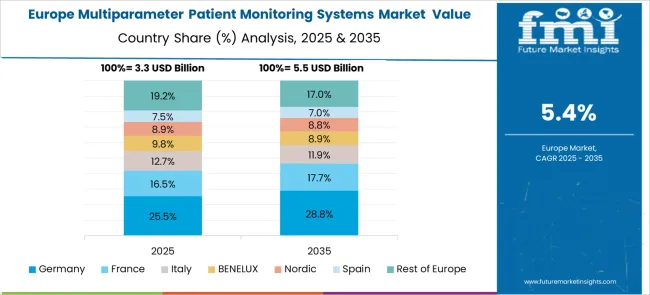
The European multiparameter patient monitoring systems market demonstrates sophisticated development across major economies with Germany leading through its precision medical technology excellence and advanced healthcare infrastructure capabilities, supported by companies like Drägerwerk AG & Co. KGaA pioneering comprehensive patient monitoring solutions with focus on critical care, hospital applications, and geriatric patient monitoring while prioritizing clinical accuracy and regulatory compliance. The UK shows strength in healthcare system integration and evidence-based monitoring protocols, with companies specializing in advanced patient monitoring technologies that meet strict clinical standards and provide consistent diagnostic outcomes.
France contributes through companies delivering integrated patient monitoring solutions and healthcare technology excellence for comprehensive hospital applications. Italy and Spain demonstrate growth in specialized monitoring systems for ambulatory and home care settings. The market benefits from stringent EU medical device regulations, established healthcare infrastructure, and growing on digital health integration positioning Europe as key centre for advanced patient monitoring technologies.
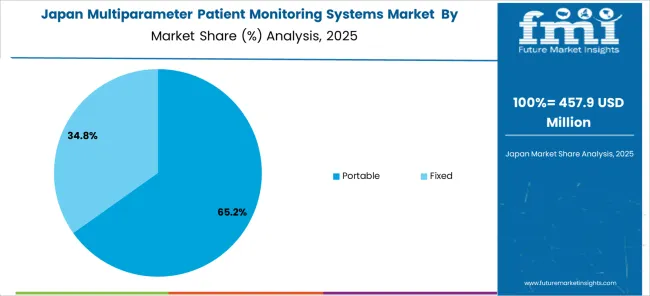
The Japanese multiparameter patient monitoring systems market demonstrates steady growth driven by precision healthcare focus, advanced medical technologies, and healthcare system preference for high-quality monitoring systems ensuring superior clinical accuracy and patient safety compliance throughout hospital operations. International companies establish presence through cutting-edge patient monitoring technologies aligning with Japan's sophisticated healthcare industry and stringent quality standards while incorporating AI integration and automated monitoring capabilities.
The market focused automated clinical monitoring systems, precision diagnostic excellence, and advanced patient care innovations reflecting Japanese healthcare precision and attention to detail in medical processes. Growing investment in digital health technologies supports intelligent monitoring systems with real-time patient data analysis, predictive analytics, and optimized clinical performance. Japanese healthcare providers prioritize system reliability, consistent clinical outcomes, and regulatory compliance, creating opportunities for premium patient monitoring solutions delivering exceptional performance across hospitals, home care settings, and ambulatory surgical centers requiring highest quality standards.
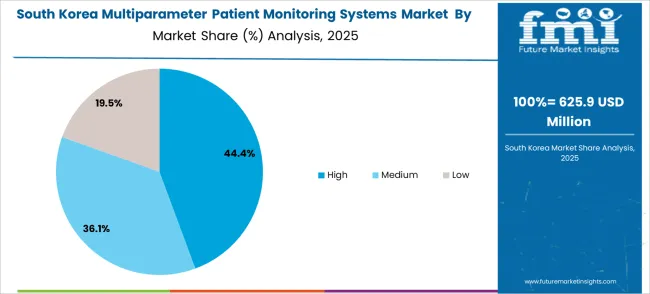
The South Korean multiparameter patient monitoring systems market shows exceptional growth potential driven by expanding healthcare infrastructure, increasing adoption of digital health technologies, and growing demand for comprehensive patient monitoring requiring efficient and advanced clinical solutions. The market benefits from South Korea's technological advancement capabilities and increasing focus on healthcare innovation competitiveness driving investment in modern patient monitoring technologies meeting international clinical standards and regulatory requirements.
Korean healthcare facilities increasingly adopt automated monitoring systems, advanced patient care equipment, and integrated clinical technologies improving patient outcomes and operational efficiency while ensuring safety compliance. Growing influence of Korean medical technology innovations in global markets supports demand for sophisticated patient monitoring solutions ensuring clinical excellence while maintaining cost-effectiveness. Integration of IoT principles and smart healthcare technologies creates opportunities for intelligent monitoring systems with connectivity features, predictive capabilities, and real-time clinical optimization across diverse healthcare applications.

The multiparameter patient monitoring systems market is characterized by competition among established medical device manufacturers, specialized monitoring technology companies, and emerging digital health players. Companies are investing in advanced sensor technologies, artificial intelligence integration, cloud-based platforms, and wireless connectivity solutions to deliver comprehensive, reliable, and user-friendly monitoring systems. Product innovation, regulatory compliance, and strategic partnerships are central to strengthening market position and expanding customer base.
Koninklijke Philips N.V., Netherlands-based, leads the market with 23.0 percent global value share, offering comprehensive monitoring solutions with advanced connectivity and analytics capabilities. The company focuses on integrated healthcare solutions that combine monitoring devices with data management platforms. SternMed GmbH provides specialized monitoring systems with importance on reliability and clinical accuracy. Spacelabs Healthcare (OSI Systems, Inc.) delivers comprehensive monitoring solutions for various healthcare settings with focus on user-friendly interfaces and interoperability.
ICU Medical, Inc. focuses on critical care monitoring solutions with main focus on patient safety and clinical outcomes. GE Healthcare provides advanced monitoring systems with artificial intelligence integration and cloud-based data management. Drägerwerk AG & Co. KGaA offers comprehensive monitoring solutions for critical care environments with priority on reliability and performance. Medtronic plc provides integrated monitoring solutions that connect with other medical devices and healthcare systems.
| Items | Values |
|---|---|
| Quantitative Units (2025) | USD 13.7 Billion |
| Device | Portable systems, Fixed systems |
| Acuity Level | High acuity, Medium acuity, Low acuity |
| Age Group | Geriatric, Pediatric, Adult |
| End Use | Hospitals, Home care settings, Ambulatory surgical centers, Others |
| Regions Covered | North America, Europe, Asia Pacific, Latin America, Middle East & Africa |
| Countries Covered | United States, Canada, United Kingdom, Germany, France, China, Japan, South Korea, India, Brazil, Australia and 40+ countries |
| Key Companies Profiled | Koninklijke Philips NV, GE Healthcare, Medtronic plc, Drägerwerk AG & Co KGaA, MASIMO Corporation, Spacelabs Healthcare (OSI Systems Inc), Shenzhen Mindray Bio-Medical Electronics Co Ltd, Skanray Technologies, Schiller AG, SternMed GmbH, ICU Medical Inc |
| Additional Attributes | Dollar sales by monitoring parameters and connectivity options, regional demand trends, competitive landscape, technology adoption patterns, integration with electronic health records, innovations in wireless monitoring, AI-powered analytics, and telemedicine compatibility |
Device:
Acuity Level:
Age Group:
End Use:
Region:
The global multiparameter patient monitoring systems market is estimated to be valued at USD 13.7 billion in 2025.
The market size for the multiparameter patient monitoring systems market is projected to reach USD 24.1 billion by 2035.
The multiparameter patient monitoring systems market is expected to grow at a 5.8% CAGR between 2025 and 2035.
The key product types in multiparameter patient monitoring systems market are portable and fixed.
In terms of acuity level outlook, high segment to command 45.8% share in the multiparameter patient monitoring systems market in 2025.






Full Research Suite comprises of:
Market outlook & trends analysis
Interviews & case studies
Strategic recommendations
Vendor profiles & capabilities analysis
5-year forecasts
8 regions and 60+ country-level data splits
Market segment data splits
12 months of continuous data updates
DELIVERED AS:
PDF EXCEL ONLINE
Patient-Controlled Analgesia Pumps Market Size and Share Forecast Outlook 2025 to 2035
Patient Transportation Market Size and Share Forecast Outlook 2025 to 2035
Patient Handling Equipment Market Size and Share Forecast Outlook 2025 to 2035
Patient Positioning Equipment Market Size and Share Forecast Outlook 2025 to 2035
Patient Self-Service Kiosks Market Size and Share Forecast Outlook 2025 to 2035
Patient Recliners Market Size and Share Forecast Outlook 2025 to 2035
Patient Transport Services Market Size and Share Forecast Outlook 2025 to 2035
Patient Engagement Platforms Market Size and Share Forecast Outlook 2025 to 2035
Patient Registry Software Market Size and Share Forecast Outlook 2025 to 2035
Patient Positioning System Analysis by Product Type and by End User through 2035
Patient Lateral Transfer Market - Innovations, Demand & Forecast 2035
Patient Identification Wristbands Market Analysis – Size, Trends & Forecast 2025 to 2035
Patient Hygiene Aids Market – Demand & Forecast 2024 to 2034
Patient Portal Market – Growth & Forecast 2024-2034
Patient-Controlled Injectors Market
Patient Health Management Market
Patient Monitoring System Market Size and Share Forecast Outlook 2025 to 2035
Patient Monitoring Accessories Market Size and Share Forecast Outlook 2025 to 2035
Patient Monitoring Devices Market Size and Share Forecast Outlook 2025 to 2035
Patient Monitoring Pods Market

Thank you!
You will receive an email from our Business Development Manager. Please be sure to check your SPAM/JUNK folder too.
Chat With
MaRIA